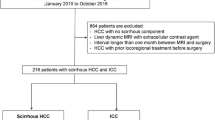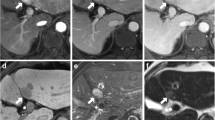Abstract
Purpose
To assess the added value of intratumoral ancillary features to conventional enhancement pattern-based diagnosis of hepatocellular carcinoma (HCC) on gadoxetic acid-enhanced magnetic resonance imaging (MRI).
Materials and methods
A total of 773 consecutive patients with surgically resected 773 primary hepatic tumors (699 HCCs, 63 intrahepatic cholangiocarcinomas, and 11 benign nodules) who underwent gadoxetic acid-enhanced MRI were retrospectively identified. Enhancement patterns and three ancillary features of capsule, septum, and T2 spotty hyperintensity were assessed by two radiologists. Performance of enhancement pattern-based diagnosis of HCC was compared to diagnosis of HCC based on enhancement pattern plus ancillary features.
Results
Enhancement patterns were positive (arterial diffuse hyperenhancement with washout) for 562 (72.7%) tumors, negative (no arterial hyperenhancement and no washout) for 75 (9.7%), and inconclusive (either no arterial hyperenhancement or no washout) for 136 (17.6%). Capsule was observed in 498 (64.4%) tumors, septum in 521 (67.3%), and T2 spotty hyperintensity in 107 (13.8%). The accuracy and sensitivity of HCC diagnosis was improved significantly after adding at least one ancillary feature compared with enhancement pattern-based diagnosis of HCCs (79.9% vs. 91.1% for accuracy, p < 0.0001 and 79.1% vs. 92.0% for sensitivity, p < 0.0001) with a minor tradeoff in specificity (87.8% vs. 82.4%, p = 0.125). Adding at least two ancillary features improved accuracy (88.1%, p < 0.0001) and sensitivity (88.1%, p < 0.0001) without changing specificity (87.8%, p = 1.0).
Conclusion
Adding intratumoral ancillary features of capsule, septum and T2 spotty hyperintensity to conventional enhancement patterns on gadoxetic acid-enhanced MRI improved accuracy and sensitivity, while maintaining specificity for HCC diagnosis.





Similar content being viewed by others
Abbreviations
- HCC:
-
Hepatocellular carcinoma
- MRI:
-
Magnetic resonance imaging
- EASL:
-
European Association for the Study of the Liver
- AASLD:
-
American Association for the Study of Liver Diseases
- CT:
-
Computed tomography
- HBP:
-
Hepatobiliary phase
- ECCM:
-
Extracellular contrast media
- LI-RADS:
-
The liver imaging reporting and data system
- IMCC:
-
Intrahepatic mass-forming cholangiocarcinoma
- SI:
-
Signal intensity
- T1WI:
-
T1-weighted image
- T2WI:
-
T2-weighted image
- PPV:
-
Positive predictive value
- NPV:
-
Negative predictive value
References
Bruix J, Sherman M, American Association for the Study of Liver D (2011) Management of hepatocellular carcinoma: an update. Hepatology 53:1020–1022. doi:https://doi.org/10.1002/hep.24199
European Association For The Study Of The L, European Organisation For R, Treatment Of C (2012) EASL-EORTC clinical practice guidelines: management of hepatocellular carcinoma. J Hepatol 56:908–943. doi:https://doi.org/10.1016/j.jhep.2011.12.001
Forner A, Vilana R, Ayuso C, et al. (2008) Diagnosis of hepatic nodules 20 mm or smaller in cirrhosis: prospective validation of the noninvasive diagnostic criteria for hepatocellular carcinoma. Hepatology 47:97–104. doi:https://doi.org/10.1002/hep.21966
Bolondi L, Gaiani S, Celli N, et al. (2005) Characterization of small nodules in cirrhosis by assessment of vascularity: the problem of hypovascular hepatocellular carcinoma. Hepatology 42:27–34. doi:https://doi.org/10.1002/hep.20728
Choi SH, Byun JH, Lim YS, et al. (2016) Diagnostic criteria for hepatocellular carcinoma 3 cm with hepatocyte-specific contrast-enhanced magnetic resonance imaging. J Hepatol 64:1099–1107. doi:https://doi.org/10.1016/j.jhep.2016.01.018
van den Bos IC, Hussain SM, Dwarkasing RS, et al. (2007) MR imaging of hepatocellular carcinoma: relationship between lesion size and imaging findings, including signal intensity and dynamic enhancement patterns. J Magn Reson Imaging 26:1548–1555. doi:https://doi.org/10.1002/jmri.21046
Lee YJ, Lee JM, Lee JS, et al. (2015) Hepatocellular carcinoma: diagnostic performance of multidetector CT and MR imaging-a systematic review and meta-analysis. Radiology 275:97–109. doi:https://doi.org/10.1148/radiol.14140690
Kierans AS, Kang SK, Rosenkrantz AB (2016) The diagnostic performance of dynamic contrast-enhanced MR imaging for detection of small hepatocellular carcinoma measuring up to 2 cm: a meta-analysis. Radiology 278:82–94. doi:https://doi.org/10.1148/radiol.2015150177
Kudo M, Matsui O, Izumi N, et al. (2014) JSH consensus-based clinical practice guidelines for the management of hepatocellular carcinoma: 2014 update by the liver cancer study group of Japan. Liver Cancer 3:458–468. doi:https://doi.org/10.1159/000343875
Korean Liver Cancer Study G, National Cancer Center K (2015) 2014 KLCSG-NCC korea practice guideline for the management of hepatocellular carcinoma. Gut Liver 9:267–317. doi:https://doi.org/10.5009/gnl14460
Joo I, Lee JM, Lee DH, et al. (2015) Noninvasive diagnosis of hepatocellular carcinoma on gadoxetic acid-enhanced MRI: can hypointensity on the hepatobiliary phase be used as an alternative to washout? Eur Radiol 25:2859–2868. doi:https://doi.org/10.1007/s00330-015-3686-3
Mitchell DG, Bruix J, Sherman M, Sirlin CB (2015) LI-RADS (Liver Imaging Reporting and Data System): summary, discussion, and consensus of the LI-RADS Management Working Group and future directions. Hepatology 61:1056–1065. doi:https://doi.org/10.1002/hep.27304
Ishizaki M, Ashida K, Higashi T, et al. (2001) The formation of capsule and septum in human hepatocellular carcinoma. Virchows Arch 438:574–580
Kadoya M, Matsui O, Takashima T, Nonomura A (1992) Hepatocellular carcinoma: correlation of MR imaging and histopathologic findings. Radiology 183:819–825. doi:https://doi.org/10.1148/radiology.183.3.1316622
Kojiro M, Nakashima T (1987) Pathology of hepatocellular carcinoma. In: Okuda K, Ishak KG (eds) Neoplasm of the Liver. Tokyo, Japan: Springer, pp 81–104
Qian H, Li S, Ji M, Lin G (2016) MRI characteristics for the differential diagnosis of benign and malignant small solitary hypovascular hepatic nodules. Eur J Gastroenterol Hepatol 28:749–756. doi:https://doi.org/10.1097/MEG.0000000000000642
Park HJ, Kim YK, Park MJ, Lee WJ (2013) Small intrahepatic mass-forming cholangiocarcinoma: target sign on diffusion-weighted imaging for differentiation from hepatocellular carcinoma. Abdom Imaging 38:793–801. doi:https://doi.org/10.1007/s00261-012-9943-x
Ishigami K, Yoshimitsu K, Nishihara Y, et al. (2009) Hepatocellular carcinoma with a pseudocapsule on gadolinium-enhanced MR images: correlation with histopathologic findings. Radiology 250:435–443. doi:https://doi.org/10.1148/radiol.2501071702
Suh YJ, Kim MJ, Choi JY, et al. (2011) Differentiation of hepatic hyperintense lesions seen on gadoxetic acid-enhanced hepatobiliary phase MRI. AJR Am J Roentgenol 197:W44–52. doi:https://doi.org/10.2214/AJR.10.5845
Landis JR, Koch GG (1977) The measurement of observer agreement for categorical data. Biometrics 33:159–174
Blaschke EM, Rao VL, Xiong L, et al. (2016) Multiphase multi-detector row computed tomography imaging characteristics of large (>5 cm) focal hepatocellular carcinoma. J Comput Assist Tomogr 40:493–497. doi:https://doi.org/10.1097/RCT.0000000000000379
Kanata N, Yoshikawa T, Ohno Y, et al. (2013) HCC-to-liver contrast on arterial-dominant phase images of EOB-enhanced MRI: comparison with dynamic CT. Magn Reson Imaging 31:17–22. doi:https://doi.org/10.1016/j.mri.2012.06.012
Marti-Bonmati L (1997) MR imaging characteristics of hepatic tumors. Eur Radiol 7:249–258. doi:https://doi.org/10.1007/s003300050146
Fujimoto M, Nakashima O, Komuta M, et al. (2010) Clinicopathological study of hepatocellular carcinoma with peliotic change. Oncol Lett 1:17–21. doi:https://doi.org/10.3892/ol_00000003
Honda H, Onitsuka H, Murakami J, et al. (1992) Characteristic findings of hepatocellular carcinoma: an evaluation with comparative study of US, CT, and MRI. Gastrointest Radiol 17:245–249
Author information
Authors and Affiliations
Corresponding author
Ethics declarations
Conflict of interest
No conflict of interest.
Electronic supplementary material
Below is the link to the electronic supplementary material.
Rights and permissions
About this article
Cite this article
Min, J.H., Kim, Y.K., Sinn, D.H. et al. Adding ancillary features to enhancement patterns of hepatocellular carcinoma on gadoxetic acid-enhanced magnetic resonance imaging improves diagnostic performance. Abdom Radiol 43, 2309–2320 (2018). https://doi.org/10.1007/s00261-018-1480-9
Published:
Issue Date:
DOI: https://doi.org/10.1007/s00261-018-1480-9




